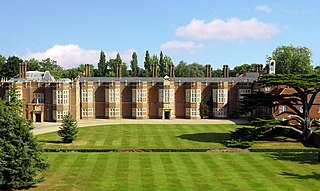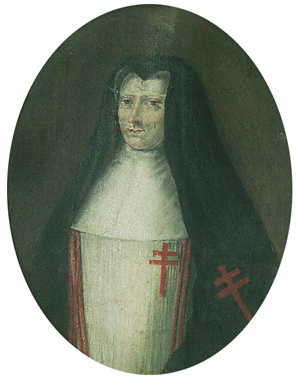
A priory is a monastery of men or women under religious vows that is headed by a prior or prioress. Priories may be houses of mendicant friars or nuns, or monasteries of monks or nuns. Houses of canons regular and canonesses regular also use this term, the alternative being "canonry".

The Order of Canons Regular of Prémontré, also known as the Premonstratensians, the Norbertines and, in Britain and Ireland, as the White Canons, is a religious order of canons regular of the Catholic Church founded in Prémontré near Laon in 1120 by Norbert of Xanten, who later became Archbishop of Magdeburg. Premonstratensians are designated by OPraem following their name.
A double monastery is a monastery combining separate communities of monks and of nuns, joined in one institution to share one church and other facilities. The practice is believed to have started in the East at the dawn of monasticism. It is considered more common in the monasticism of Eastern Christianity, where it is traceable to the 4th century. In the West the establishment of double monasteries became popular after Columbanus and sprang up in Gaul and in Anglo-Saxon England. Double monasteries were forbidden by the Second Council of Nicaea in 787, though it took many years for the decree to be enforced. Double monasteries were revived again after the 12th century in a significantly different way when a number of religious houses were established on this pattern among Benedictines and possibly the Dominicans. The 14th-century Bridgittines were purposely founded using this form of community.
The Canons Regular of the Holy Sepulchre were a Catholic religious order of canons regular of the Rule of Saint Augustine, said to have been founded in the Church of the Holy Sepulchre in Jerusalem, then the capital of the Kingdom of Jerusalem, and recognised in 1113 by a Papal bull of Pope Paschal II. Other accounts have it that they were founded earlier, during the rule of Godfrey of Bouillon (1099–1100).

Canons regular are priests who live in community under a rule and are generally organised into religious orders, differing from both secular canons and other forms of religious life, such as clerics regular, designated by a partly similar terminology.
Canoness is a member of a religious community of women living a simple life. Many communities observe the monastic Rule of St. Augustine. The name corresponds to the male equivalent, a canon. The origin and Rule are common to both. As with the canons, there are two types: canonesses regular, who follow the Augustinian Rule, and secular canonesses, who follow no monastic Rule of Life.

Prior is an ecclesiastical title for a superior in some religious orders. The word is derived from the Latin for "earlier" or "first". Its earlier generic usage referred to any monastic superior. In abbeys, a prior would be lower in rank than the abbey's abbot or abbess.
The Crosiers or Brethren of the Cross or crutched friars is a general name for several loosely related Catholic orders, mostly canons regular. Their names derive from their devotion to the Holy Cross. They were founded in the 12th and 13th centuries, during the era of the crusades in the Holy Land. These orders tended to maintain hospitals and care for the sick. Currently, the term "crosiers" most frequently refers to the Canons Regular of the Order of the Holy Cross originating from Belgium, but it could also refer to at least five other orders from Jerusalem, Portugal, Italy, Bohemia, Poland–Lithuania, and a group of friars in England and Ireland.

Lamspringe Abbey is a former religious house of the English Benedictines in exile, at Lamspringe near Hildesheim in Germany.
Mother Lettice Mary Tredway, C.R.L.,, courtesy title Lady Tredway, was an English canoness regular and abbess who founded a monastery for the English members of her Order in 17th-century Europe.

New Hall School is a Catholic co-educational private boarding and day school in the village of Boreham in the City of Chelmsford, Essex, England. It was founded in 1642 in the Low Countries, now Belgium, by sisters of the Catholic order Canonesses of the Holy Sepulchre and moved to its current location, the former Tudor Palace of Beaulieu in Essex, in 1799. It is the only Catholic Independent school in the Brentwood diocese, and one of the oldest and largest in the country.

St Augustine's Priory School, is an independent Catholic girls' school in the London Borough of Ealing, England. It was founded and staffed by nuns from the priory, though the school has been run by a lay head since 1996. The school consists of Nursery (3-4) Prep, Junior (7-11) and Senior (11-18) departments and welcomes girls of all faiths. In 2014, it was in the top three best performing GCSE schools in Ealing.
The Society of the Precious Blood is an Anglican religious order of contemplative sisters with convents in England, Lesotho and South Africa. The sisters follow the Rule of St Augustine.

Herkenrode Abbey was a Catholic monastery of Cistercian nuns located in Kuringen, part of the municipality of Hasselt, which lies in the province of Limburg, Belgium.
The Missionary Sisters of the Immaculate Heart of Mary (I.C.M.) are a Roman Catholic religious institute of pontifical right of women, dedicated to the service of those in need in the Third World.

Male Castle, Bruges. A community of the Canonesses Regular of the Holy Sepulchre. It originated in Bruges in the 11th century, and between 1954 and 2013 was settled in Male Castle in Male, Sint-Kruis, Bruges, West Flanders, Belgium.
Susan Hawley renamed Mary of the Conception was an English born Sepulchrine prioress in Liège. The organisation continues at three communities in south-east England in 2021. New Hall School in Chelmsford credits Hawley with founding their school in 1642.

Mary "Christina" Dennett was a British prioress of the Canonesses Regular of the Holy Sepulchre in Liège from 1770 to 1781. New Hall School in Chelmsford credits Susan Hawley with founding their school, but it was Dennett who expanded the convent's school in Liege to have an international reputation in the 18th century, years before it moved to England in 1794.











